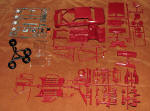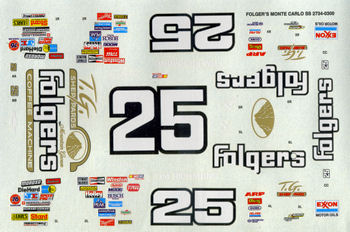
Monogram 1/24 Folger's Monte Carlo
| KIT #: | 2734 |
| PRICE: | $4.35 at the BX in 1986 |
| DECALS: | One option |
| REVIEWER: | Scott Van Aken |
| NOTES: | 1986 issue |

| HISTORY |
Tim Richmond (June 7, 1955 – August 13, 1989) was an American race car driver from Ashland, Ohio. He competed in IndyCar racing before transferring to NASCAR's Winston Cup Series (now Sprint Cup Series). Richmond was one of the first drivers to change from open wheel racing to NASCAR stock cars full-time, which has since become an industry trend. He won the 1980 Indianapolis 500 Rookie of the Year award and had 13 victories during eight NASCAR seasons.
Richmond achieved his top NASCAR season in 1986 when he finished third in points. He won seven races that season, more than any other driver on the tour. When he missed the season-opening Daytona 500 in February 1987, media reported that he had pneumonia. The infection most likely resulted from his compromised immune system, which was weakened by AIDS. The disease drastically shortened his life. Despite the state of his health, Richmond competed in eight races in 1987, winning two events and one pole position before his final race in August of that year. He attempted a comeback in 1988 before NASCAR banned him for testing positive for a banned substance; after NASCAR insisted on access to his entire medical record before reinstating him, Richmond withdrew from racing. NASCAR later stated their original test was inaccurate.
Richmond grew up in a wealthy family and lived a freewheeling lifestyle, earning him the nickname "Hollywood". In describing Richmond's influence in racing, Charlotte Motor Speedway president Humpy Wheeler said: "We've never had a race driver like Tim in stock car racing. He was almost a James Dean-like character." When Richmond was cast for a bit part in the 1983 movie Stroker Ace, "He fell right in with the group working on the film," said director Hal Needham. Cole Trickle, the main character in the movie Days of Thunder, played by Tom Cruise, was loosely based on Richmond and his interaction with Harry Hyde and Rick Hendrick.
| THE KIT |
 Back
in the late 1980s and early 1990s, NASCAR kits were a really big thing. For a
while, some kits were valued at well over $100 and one of them, a kit I still
have, the Bill Elliot Coors Thunderbird, was selling from specialty shops for
$150. Part of this came from model kit makers no longer doing cars with beer or
tobacco advertising for the fear that if little ones saw them, they would
immediately hanker for a brew and a smoke. However, like Beanie Babies, the
bottom fell out of the market and even rare kits can now be found for
considerably less than what they were valued in the hey days.
Back
in the late 1980s and early 1990s, NASCAR kits were a really big thing. For a
while, some kits were valued at well over $100 and one of them, a kit I still
have, the Bill Elliot Coors Thunderbird, was selling from specialty shops for
$150. Part of this came from model kit makers no longer doing cars with beer or
tobacco advertising for the fear that if little ones saw them, they would
immediately hanker for a brew and a smoke. However, like Beanie Babies, the
bottom fell out of the market and even rare kits can now be found for
considerably less than what they were valued in the hey days.  without the
need for paint. Nice for kids and something a bit different for the more mature
modeler. I was pleased to see that the decals were in excellent condition,
undoubtedly thanks to my careful storage of my kits to prevent issues from heat
or moisture. While Monogram decals from this time period tend to be a bit thick
and also a tad transparent, with the use of hot water, they do conform well. Not
really an issue when it comes to these slab sided NASCARs.
without the
need for paint. Nice for kids and something a bit different for the more mature
modeler. I was pleased to see that the decals were in excellent condition,
undoubtedly thanks to my careful storage of my kits to prevent issues from heat
or moisture. While Monogram decals from this time period tend to be a bit thick
and also a tad transparent, with the use of hot water, they do conform well. Not
really an issue when it comes to these slab sided NASCARs. | CONCLUSIONS |
| REFERENCES |
http://en.wikipedia.org/wiki/Tim_Richmond
December 2012 My thanks to me and my now quiescent kit collecting genes. If you would like your product reviewed fairly and fairly quickly, please contact the editor or see other details in the
Note to
Contributors.
Back to the Previews Index Page